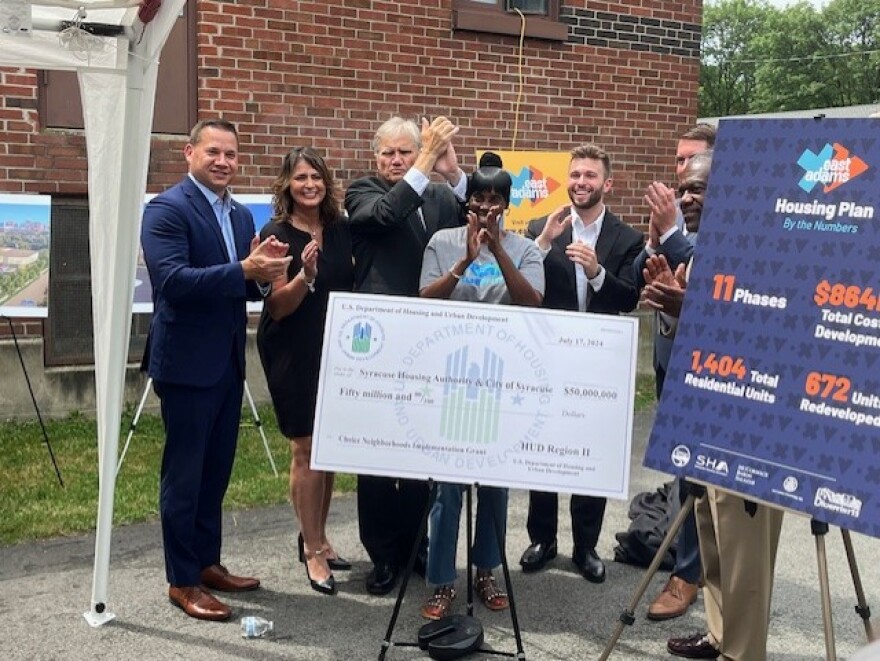Federal Housing officials stopped in Syracuse today to celebrate an unprecedented $50 million investment to redevelop the city’s historic 15th ward. The federal funds were secured by Senators Chuck Schumer and Kirsten Gillibrand, who first announced the award last week. HUD Principal Assistant for Public Housing Richard Monocchio says it’s long overdue.
“We're taking public housing that has served its purpose, but it needs to be redeveloped," Monocchio said. "And every single apartment, every single public housing unit, is going to be replaced. But it's not just public housing, right? It's workforce housing. It's getting people to be able to live near jobs.”

The Syracuse Housing Authority will replace more than 600 units of distressed public housing with affordable, modern, accessible apartments. The SHA will also "activate vacant parcels" to create an 1,400 new units. Community navigator Tara Harris is a lifetime resident of public housing. It was her job to persuade residents to attend numerous community meetings to create a vision for their new neighborhood.
“I'm getting phone calls now. 'Oh, we got the $50 million? Yeah. Remember those meetings? They matter'," Harris said. "I worked very hard to make sure that residents were informed and that their voices were heard every step of the way. We were not going to have it any other way. It's our community so we're going to run it like it's our community.”
The $50 million in federal funding complements hundreds of millions more in state, city, county, and foundation funding. Leaders see the eventual removal of the I-81 viaduct as an opportunity to reinvest and reimagine a neighborhood that was bulldozed to build the highway.
Groundbreaking for the mixed income, senior and supportive housing phases is expected to take place this fall.

The SHA provided these key components of the overall plan:
• Replacing over 600 aging public housing units in Pioneer Homes and McKinney Manor and activating vacant parcels to create over 1400 new units. The redevelopment will feature a rich mix of high-quality, energy-efficient housing options including apartments, townhomes and single-family homes, aimed at enhancing resident access to downtown Syracuse and University Hill’s vibrant urban centers.
• Using a phased approach to redevelopment to minimize disruption of the residents. Replacement units will be appropriately sized to meet the needs of returning families, and all current eligible residents are given priority to return.
• Improving access to higher quality education by building a pipeline of students for the new world-class Science, Technology, Engineering, Arts, and Math (STEAM) High School and supporting the development of the Children Rising Center, which will include an early learning center and space for health, wellness, and recreational opportunities.
• Accelerating economic opportunities through workforce training and business development. This includes transforming new ground-floor commercial spaces and vacant buildings into vibrant retail hubs for small, local, minority, and women-owned businesses. A Black Indigenous People of Color (BIPOC) Real Estate Development & Entrepreneurship Incubator will ensure minority entrepreneurs have clear access to these new opportunities, and a Neighborhood Employment and Training Center will connect residents to jobs.
• Enhancing neighborhood connectivity, visibility, and safety through public infrastructure improvements and the use of Crime Prevention Through Environmental Design (CPTED) principles. This will create more green space and improve recreational opportunities, public safety, and food access.
• Placemaking and multi-park improvements, including the development of a new “Linear Park” connecting Roesler and Wilson Parks and a neighborhood museum to celebrate the legacy of the Historic 15th Ward.
• Offering wraparound services and support to ensure residents have access to essential resources. This includes family-centered case management, educational, health, and career services, and mobility counseling to help mitigate transition barriers of relocation or re-occupancy




